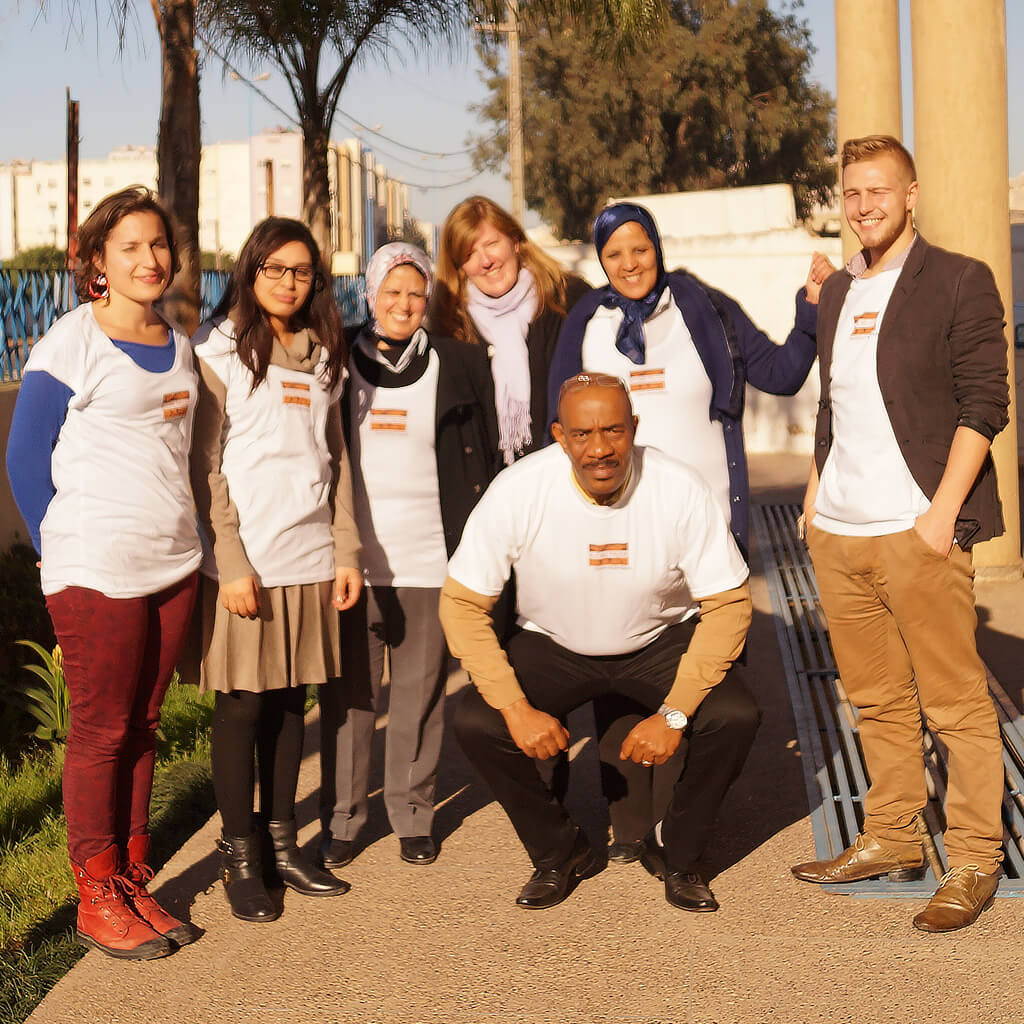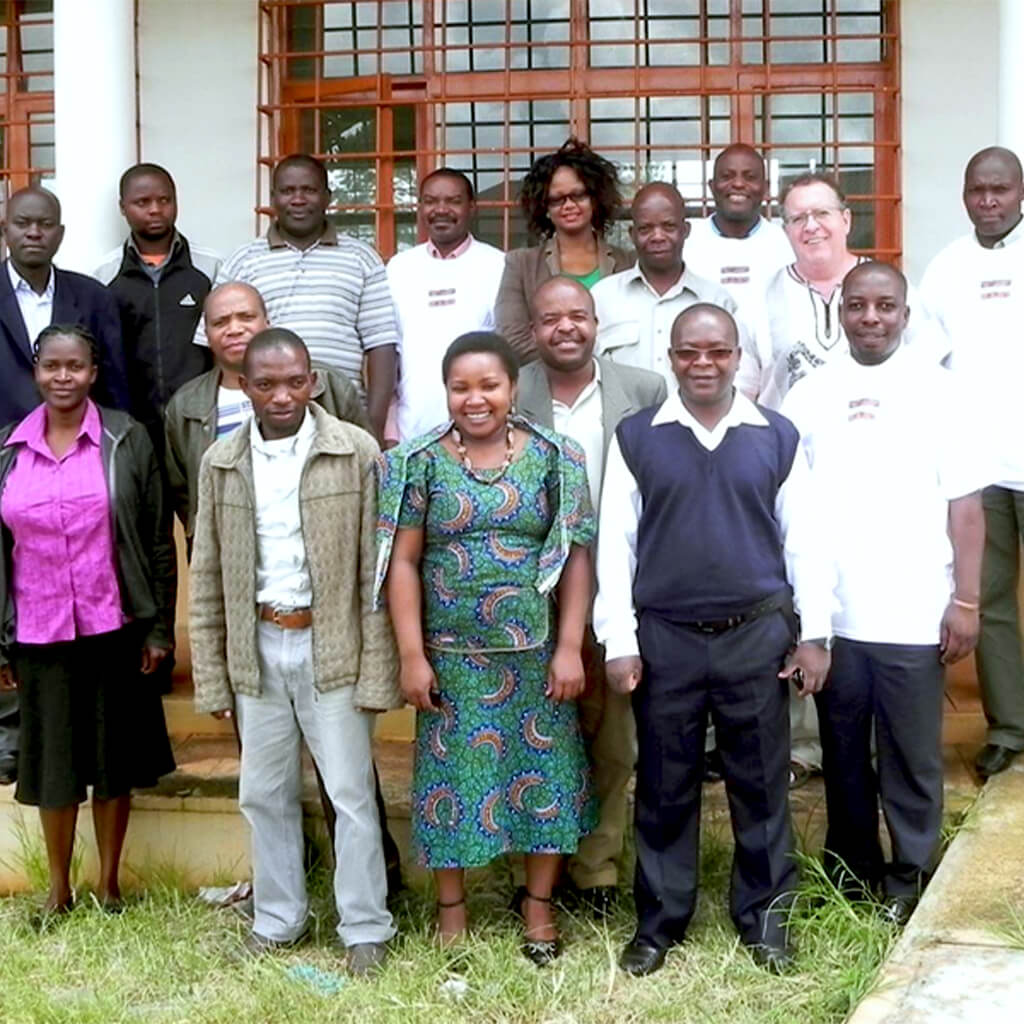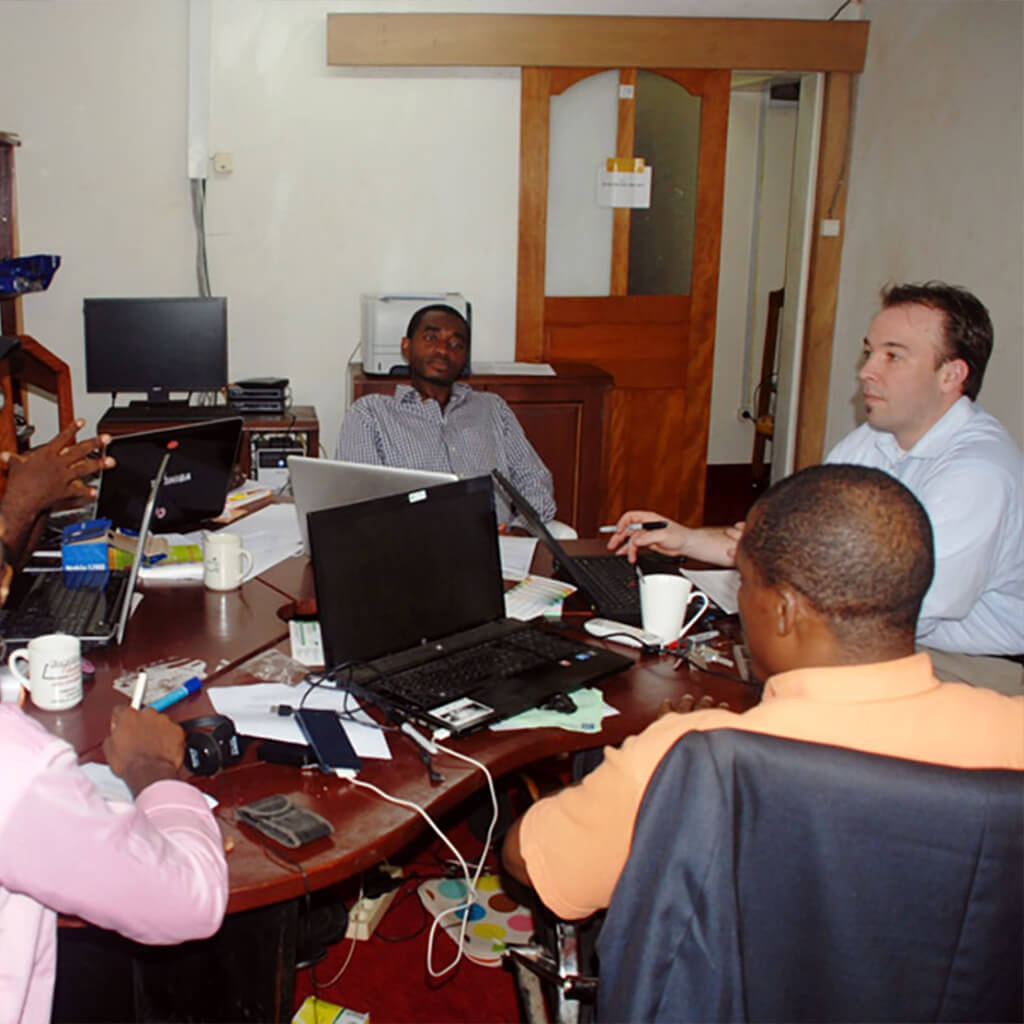Christine Cantin
Althelia Climate Fund
AIDER, Asociacion Para La Investigacion Y El Desarollo Integral
Ecotierra
CONTEXT AND ISSUES
The project is located in the REDD (Reduced Emissions from Deforestation and Degradation) Tampobata buffer zone, a preservation area of over 300,000 hectares. The goal of the project is to reforest at least 4000 hectares of the REDD zone with productive cocoa forests.
The first phase of the project, covering 300 hectares, is funded by the Althelia Climate Fund. Established in Europe, the Fund invests in projects in Africa and Latin America targeting the reduction of CO2 by promoting sustained use of the land and the conservation of old-growth forests. Those projects generate forest carbon credits that can be sold on the voluntary compensation market. The group gave Ecotierra a mandate to assess the social situation in the area of the project, participate in the establishment of the cooperative, and support the latter in marketing the cocoa.
The Peruvian organization AIDER is a partner in the project and handles all relevant environmental aspects, including the environmental follow-up for carbon credits. A key member of Ecotierra, on site in Peru, has completed the task of recruiting leaders for the future cocoa producers that will form the cooperative. The next steps in the project are the legal establishment of the cooperative and the signature of agreements with producers to allow them to begin planting. It takes about two years for the first cocoa crop to be ready for sale. The installation of infrastructures for the cooperative will be carried out during that time, as will the search for additional donors/investors and future cocoa buyers.
Ecotierra is the Canadian partner responsible for ensuring the cooperative’s legal creation, overseeing its establishment and proper operation (receiving the cocoa, fermentation, drying and packaging), and marketing the cocoa. It reached out to Public Relations Without Borders (PRWB), asking the organization to support and accompany its people at a critical moment of the cocoa initiative project.
PRWB’S ROLE
To support the efforts of the small association, PRWB must conduct an external communications assessment and help it to draw up a communications plan. Then, strategies must be identified to implement external communications activities for potential investors and buyers of the cooperative’s products. And lastly, it is important to begin a concrete and effective implementation of communications tools and means.
MISSION
| Date | Mission Head |
| October 2014 | Christine Cantin |
RESULTS
The mission of PRWB made a positive contribution to the advancement of the cocoa initiative project in terms of communications, both from a strategic and operational standpoint. More specifically, the communications plan that was drawn up highlighted the project’s strengths and weaknesses, axes of communication, and broad outlines of communications strategies, and identified the most relevant courses of action to attain targeted goals. From an operational perspective, the activities carried out during the mission contributed to the development of visual material that will be used to prepare the communications tools identified in the plan. It was agreed that the mission head would stay in touch with Ecotierra to provide strategic advice concerning the application of the plan, as required. Moreover, it would be a good idea to plan a second mission to evaluate the implementation of the communications plan.
Tanzania Union of Parents Secondary Schools (TUPSS)
Terre sans frontières (TSF)
Context and issues
About 70% of Tanzania’s population is rural. Children under the age of 14 make up close to 50% of the country’s population. In rural areas, the private sector is attempting to compensate for inadequate education resources.
The Tanzania Union of Parents Secondary Schools (TUPSS) is an NGO founded in 2000 to improve educational conditions and take advantage of the pooling of resources. There were seven private secondary schools when it was founded. In 2014, TUPSS has been re-energized with a new executive committee has been formed and the addition of three new schools, for a student body of about 10,000 (60% girls and 40% boys). Most of the schools are located in rural areas in the regions of Arusha, Kilimanjaro and Moshi, and most are co-ed, with a few schools for boys or girls only. Three schools are outside these regions: one in Dar es Salaam and the two others are in Tabora and Manyara.
PRWB’s mission comes at an ideal time. TUPSS is growing and is in dire need of basic communications tools and a website. Communications with and among the members must be improved, and public awareness of TUPSS must be raised, especially to support fundraising efforts for projects at the schools.
PRWB’s role
PRWB completed a 10-day mission to Tanzania in August 2014. With the collaboration of its partner, TSF, PRWB visited 12 of the 14 member schools to meet the principals and other staff members, conduct a communications audit, examine the individual schools’ strategic plans and the activities for generating revenues and other funding sources. PRWB had two meetings with the TUPSS executive committee to conduct interviews and make preliminary recommendations. It identified many communications needs, which were used to develop a draft plan that will enable TUPSS to implement a development and promotional program in 2015.
Mission
| Date | Mission head |
| August 2014 | Taïssa Hrycay |
Results
At the post-mission meeting, the TUPSS executive committee expressed its satisfaction with the support it received from PRWB. It said that the observations, recommendations and preliminary advice provided were very useful, especially since the committee is unable to visit the schools on a regular basis. TUPSS understands the short-term priorities (mission, vision and values, dedicated communications resource, presentation of the organization and website). PRWB will provide TUPSS and TSF with a detailed report that includes an overall communications plan with concrete measures to improve its capabilities, templates for tools to help it with day-to-day management as well as a tree for the future website along with suggested content. PRWB plans to continue its relationship with TUPSS and TSF next year, by providing an advisory role as the recommendations are implemented.
AL BAYTI
CONTEXT AND ISSUES
BAYTI, which means “my house” in Arabic, is a Moroccan NGO based in Casablanca. It was created with the support of Terre des Hommes in 1994. BAYTI’s primary mission is to work with street children in Casablanca, and also in Essaouira and Kenitra (school-farm). BAYTI currently focuses on the prevention of children’s exclusion, the protection of children from all forms of violence, the psychosocial re-adaptation of children, the reintegration of families, the social and professional re-insertion of children and young people, the participation of children in the development and implementation of life projects, and the promotion of children’s rights.
BAYTI’s activities consist of three main programs: 1) Programme La Rue [street program]; 2) Programme Projet de Vie Individuelle [individual life program] and 3) La ferme école [school-farm]. Through its programs, BAYTI offers children and young people living in centres a number of activities enabling them to access their principal rights, including psycho-social assistance, medical care, legal and administrative assistance for children and their families, and a professional education and training program.
PRWB’S ROLE
To develop a strategy to increase people’s awareness of an association that promotes the rights of children with a view to enhancing its impact on civil society.
MISSION
| Date | Mission Head |
| March 2014 | Leslie Quinton |
RESULTS
Over the five days of the mission, an institutional communications plan was drawn up for the Association pour l’enfance en difficulté [association for exceptional children] in Morocco to increase people’s awareness of BAYTI and inform them of its activities. Once people become more familiar with its accomplishments, the organization will be in a position to serve them better.
Garneau-International, CÉGEP Garneau
Direcçao Nacional De Ensino Técnico-Profissional, Ministry of Education, Mozambique
CONTEXT AND ISSUES
In the provinces of Nampula and Niassa, in northern Mozambique, 41 teachers and managers from nine different schools and institutes needed support to develop learning communities that would connect schools and businesses in order to promote the areas’ entrepreneurial spirit and economic development. The project involved learning entrepreneurship through action, using hands-on, interactive workshops, and led to the establishment of nine entrepreneurship training companies, providing the necessary innovations for local socio-economic development. The training had to be given in Portuguese, the local language.
PRWB’S ROLE
Comme le volet communication n’est pas intégré au programme avant l’arrivée de RPSF, notre rôle est encore plus important. Il consiste à développer et renforcer les capacités d’élaborer et de mettre en œuvre une stratégie de promotion des produits et services dans un cadre entrepreneurial.
MISSION
| Date | Mission Head |
| March 2014 | Luc Doray |
RESULTS
The participation of PRWB broadened the field of expertise, notably regarding specific aspects of training teachers, such as ways to collect market information, the communications mix, networking with the regional community, the contest for business suggestions, and writing press releases.
The scope of the project is even more interesting given the fact that, in training teachers, the expertise provided by the mission head will reach a much greater number of future entrepreneurs.
CUSO
African Model Forest Network (AMFN)
CONTEXT AND ISSUES
The AMFN
The African Model Forest Network (AMFN) is one of seven networks that make up the International Model Forest Network. The AMFN includes two model forests in Cameroon and several others under construction in other Congo Basin and West African countries, notably in the Democratic Republic of the Congo, the Central African Republic, and Rwanda.
The African forests are brimming with natural resources. However, many of the communities that live in them are poor and marginalized. By supporting the development of model forests founded on the principles of cooperation, innovation, good governance and local leadership, the AMFN gives local communities and groups of players a voice, and helps them to get out of poverty by developing innovative and productive initiatives.
Without that process, communities would not be heard and would often find themselves in situations of conflict with other local stakeholders.
The SAMFN
The Secretariat of the African Model Forest Network (SAMFN), located in Yaoundé, Cameroon, supports the construction of model forests and the consolidation of a development and governance model. It contributes to the creation and implementation of viable environmental and development policies, and strives to strengthen partnerships. Moreover, it facilitates the transfer and sharing of knowledge in all areas involving model forests, from environmental responsibilities, sustainable development and innovation, to African unity and international solidarity.
The communications activities of the SAMFN are essential to the attainment of the AMFN’s goals. They play a key role in raising awareness in relevant populations, in the dissemination and promotion of successful cases, and in the mobilization of resources.
PRWB’S ROLE
To fulfill its communications responsibilities, the AMFN was seeking to strengthen the capacities of the communications team, both in terms of drawing up promotional plans and strategies and drafting and publishing promotional documents. Those needs meshed perfectly with the PRWB’s mission, which was to help organizations working with populations facing development challenges, by enhancing their skills in using public relations as a lever for social and economic progress. A PRWB mission head was therefore assigned to work with the AMFN as part of a skill-enhancement mission.
MISSION
| Date | Mission Head |
| March 2014 | Mathieu Larocque |
RESULTS
The AMFN communications team now has a better understanding of writing techniques required to create quality content that will attract the attention of its various target publics. Whether it is addressing donors, institutional or NGO partners, or populations that will benefit from model forest projects, the communications team should be in a position to produce content adapted to the specific needs of its target publics.
The electronic communications management training provided, notably regarding social networks, will help to expand the reach of the AMFN and lead to the sharing of strategic information with its various partners.
The study of effective Web site designs and analysis of the current AMFN Web site brought to light an urgent need to improve that essential communications channel. Even though budgets are not available in the short term for a complete restructuring, a significant change of content is possible and desirable, and can be achieved at no cost.
The establishment of a structure and well defined processes will help the communications team to target its activities and demonstrate its progress to management, while a better prioritization of tasks will allow the communications team to focus on projects with high added value.
OTIM
Context and issues
In the aftermath of the Tunisian revolution in January 2011, the public space suddenly opened up in Tunisia after decades of dictatorship. This necessitated a rapid and sometimes chaotic learning process for the media and civil society.
Access to democracy in Tunisia led to the creation or formalizing of dozens of civil organizations. Formerly silenced and ostracized players were able to operate freely in a public forum that was being redefined.
The different elements that comprise the judiciary were granted the right to free speech, which had previously been unimaginable. The Observatoire tunisien pour l’indépendance de la magistrature was created in in this context, in March 2012.
Created by its president, Ahmed Ahmouni, OTIM is a non-profit organization under the law. Former president of the Association of Tunisian Magistrates, Mr. Ahmouni set up OTIM with the aim of contributing to achieving the independence of the judiciary. In this country, emerging from decades of dictatorship, public and government agencies must be educated on the importance of this concept, essential in any democracy.
Since its inception, OTIM has taken advantage of its president’s charisma, a strategy based on a constant media presence and the disproportionate media interest in a profession that was once muzzled.
PRWB’s role
OTIM’s members are fairly active on social media, with a Twitter account and three Facebook accounts. They had already garnered recognition in the media. Through discussions prior to the mission, their needs were identified in order to structure their communications actions. The activities included communications diagnostics, stakeholder mapping, meetings with a number of stakeholders and recommendations to help them develop a communications plan.
Mission
| Date | Mission Head |
| February 2014 | Morvan Le Borgne |
Results
Through various activities and meetings, OTIM was able to grasp the importance of crafting its message, understanding who their primary stakeholders are, and identifying the role each steering committee member. The mission also identified the key elements in an integrated communications plan. There are plans to maintain contact during in the current year.
Additional Information
Equitas
Arab Network for Civic Education (ANHRE)
Context and issues
The three-year Mosharka project is funded by the European Union and set up by Equitas across a network of five countries in the Middle East and North Africa (MOAN or MENA): Jordan, Yemen, Egypt, Tunisia and Morocco.
The regional office, the Arab Network for Civic Education (ANHRE), is based in Jordan. It oversees the national partners in five countries, in collaboration with Equitas.
The Mosharka project is based on the vital role played by young people in the five countries who were at the centre of dramatic changes in the region.
With this project, the young people will be able to play and active role in promoting democracy, equality and fundamental rights and freedoms in their respective societies.
The project’s goal is to reach 2,000 youths in each country by the end of its third year, in 2016. There are, however, many challenges, for a variety of reasons: the national partner in Jordan is inactive, the work depends on the regional partner, which must work twice as hard, and resources to fill this need are insufficient. In addition, young people are quickly discouraged by the lack of follow-up due to the absence of a central database and tools to reach and communicate with them effectively.
PRWB’s role
Equitas and ANHRE agreed to call on PRWB to analyze the communications plan and suggest ways of maximizing its impact in each of the five regions, assess the Mosharka project’s communication strategy, suggest improvements, and identify strategies and tools for implement the planned activities to ensure that goals are achieved.
Mission completed
| Date | Mission Head |
| February 22 to March 3, 2014 | Louis Moubarak |
Results
With the collaboration of Equitas staff, ANHRE and the national partners in five targeted countries, PRWB set up focus groups with the coordinators, one youth per national partner and the regional partner, with the aim of analyzing the scope and efficacy of the communications (strategies and tools), in order to identify the challenges, present possible solutions, per country, and to benefit the regional partner that oversees the entire process.
In addition to developing numerous tools to help reach these objectives, PRWB made ANHRE aware of the need to grow its capabilities in human resources and in recruiting, engaging and retaining youths, as well as in governance and qualitative evaluation.






